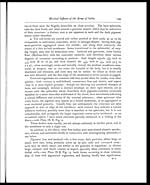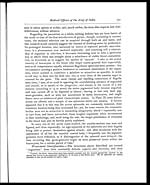Medicine - Institutions > Army health reports and medical documents > Scientific memoirs by medical officers of the Army of India > Part III, 1887 > 10 - Note on some aspects and relations of the blood-organisms in ague
(156) Page 150
Download files
Individual page:
Thumbnail gallery: Grid view | List view

150
Scientific Memoirs by
Coloured particles of an indigo-blue tint were not infrequent at later periods,
and even for days after disappearance of organisms and of the melanoid pig-
ment, to whichthey seem to be a sequel: their form was minute clumps, or plates,
translucent even when of deep hue, and such materials were commonly free,
being apparently little attractive to the leucocytes co-present.
Life-history of the Organisms. —That the parasitic forms above described
pertain to a single species, seems highly probable from their common morpho-
logy, similar conditions of appearance, and usual concurrence or succession:
yet the impossibility of tracing a continuous series of changes by inspection
alone of the blood, indicates that the successive stages of development either
do not take place in the general circulation at all, or else so obscurely as to
elude detection. No doubt isolation and culture, apart of crescent or spheroid,
might reveal the entire life-history of this polymorphic organism; and without
such aid, only a surmise of events remains available. As to growth—germs are
still unknown; but if pigmentation be a sufficient guide, it seems likely that the
incipient formation of the parasite takes place in connection with certain red
blood-discs, not at first of peculiar aspect yet now becoming tumid and bright,
and showing a pale marginal spot in which dark, active, coccus-like molecules
soon appear: such change advancing over the entire disc-area, a pigmented
spheroid would result; or if extending over only one-half the area, a crescentic
body whose membrane would then represent the uninvaded yet blanched segment
of the disc. Evidence to this effect was; I think, met with particularly in Cases
6 and 7, upon long watching and repeated scrutinies of blood at short intervals
(vide Plate IX A, Figs. 3 and 4); but I did not witness the completed transi-
tions, as development seemed to be here arrested at close of pyrexia or under
the influence of quinine. Doubtless, the organisms afterwards grow in dimen-
sions (and probably, too, their pigment), a different course being followed: thus,
the pigmented globes tend to assume the flagellate state, which can hardly, I
think, last long in the blood and seems to be followed by segmentation, rupture
and the dispersion of minute dotted plasmic specks ( ? germs), such as were
occasionally seen free; whilst the crescents are more lasting, eventually, as was
surmised, giving exit to a pigmented spherule or incipient organism (vide Plate
IX B, Fig. 5). These conjectures are based upon upwards of 200 separate
inspections of the blood, taken from native patients who might be neither
feverish nor ailing much; the blood-droplets also not seeming abnormal, though
charged with many parasites. Admitting, however, on the same evidence, the
possibility of an independent origin in the liquor sanguinis, of crescents from
spheroids, and of spherules from isolated plasma-specks, a difficulty ensues to
interpret aright the direction of changes, since retrogression was under the
circumstances at least as possible as evolution. Watched under favourable
conditions for 24 or 48 hours, no late alterations beyond those of decay, were
Set display mode to: Large image | Zoom image | Transcription
Images and transcriptions on this page, including medium image downloads, may be used under the Creative Commons Attribution 4.0 International Licence unless otherwise stated. ![]()
| Permanent URL | https://digital.nls.uk/75004474 |
|---|
| Shelfmark | IP/QB.10 |
|---|---|
| Additional NLS resources: | |




